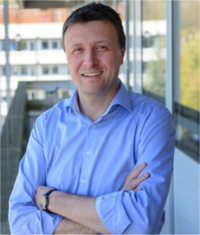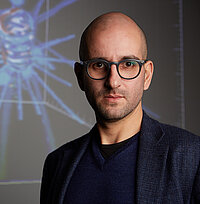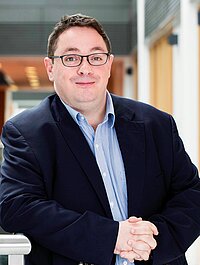Invited Speakers
 | Prof. Dr. Janet IwasaUniversity of Utah, Salt Lake City, USA Janet Iwasa is an assistant professor in the Biochemistry Department at the University of Utah. Her broad goal is to create accurate and compelling molecular and cellular visualizations that support research, learning and scientific communication. Janet's award-winning illustrations and animations have appeared in scientific journals including Nature, Science and Cell, as well as in the New York Times. Her work has also been featured on television and in museum exhibits. Janet was named a 2017 TED senior fellow and recognized as one of the "100 Leading Global Thinkers" of 2014 by Foreign Policy magazine and one of the “100 Most Creative People” of 2012 by Fast Company magazine. As a postdoctoral fellow, she created a multimedia exhibit with Nobel Laureate Jack Szostak (Harvard University) and the Museum of Science, Boston, and later worked on biological visualizations as a faculty member at Harvard Medical School. She received her Ph.D. from the University of California, San Francisco for her work on the actin cytoskeleton in the laboratory of Dyche Mullins, and completed 3D animation training at the Gnomon School of Visual Effects later that same summ | |
 | Prof. Dr. Craig CrewsYale University, New Haven, USA My lab is interested using ‘Applied Chemical Biology’ to develop novel therapeutic modalities. Enzyme inhibition has proven to be a successful paradigm for pharmaceutical development, however, it has several limitations. As an alternative, for the past 20 years, my lab has focused on developing Proteolysis Targeting Chimera (PROTAC), a new ‘controlled proteolysis’ technology that overcomes the limitations of the current inhibitor pharmacological paradigm. Based on an ‘Event-driven’ paradigm, PROTACs offer a novel, catalytic mechanism to irreversibly inhibit protein function, namely, the intracellular destruction of target proteins. This approach employs heterobifunctional molecules capable of recruiting target proteins to the cellular quality control machinery, thus leading to their degradation. We have demonstrated the ability to degrade a wide variety of targets (kinases, transcription factors, epigenetic readers) with PROTACs at picomolar concentrations. Moreover, the PROTAC technology has been demonstrated with multiple E3 ubiquitin ligases and now two PROTAC-based drug candidates are being tested in clinical trials for prostate and breast cancer.
| |
 | Prof. Dr. Patrick CramerMax Planck Institute, Göttingen, Germany Our laboratory combines integrated structural biology with functional genomics and computational biology to study the mechanisms of gene transcription and its regulation in a chromatin context. In a long-term effort, we arrived at mechanistic insights into transcription initiation at promoters of protein-coding genes (Plaschka et al. Nature 2015, 2016; Nozawa et al. Nature 2017; Schilbach et al. Nature 2017). We also reported the molecular basis for understanding transcription regulation at the step of elongation of the mRNA chain in the promoter-proximal region (Vos and Farnung Nature 2018; Vos et al. Nature 2018). These processes depend on multiple phosphorylation events, and such phosphorylation may control the partitioning of RNA polymerase II between different nuclear condensates (Boehning et al., NSMB 2018). To complement the structural studies, we also developed transient transcriptome sequencing (TT-seq), which monitors RNA synthesis and regulatory enhancer landscapes at high temporal resolution(Schwalb Science 2016; Demel Mol. Syst. Biol. 2017). In recent work, we have combined functional genomics and kinetic modeling to derive kinetic insights into transcriptonal regulation genome-wide (Gressel, Schwalb et al. Leonhardt, Eick, and Cramer, eLife 2017). In my presentation I will concentrate on the most recent findings and unpublished data on transcription regulation in a chromatin context. I will provide insights into the mechanisms of how a pioneer transcription factor, Sox2, invades the nucleosome (Dodonova et al., unpublished), how a chromatin remodeling complex of the SWI/SNF family establishes a mature nucleosome-depleted region (Wagner et al., unpublished), and how Pol II may progress through nucleosomes (Farnung Nature 2017; Farnung Nature Comm. 2018). | |
 | Prof. Dr. Luis Pedro CoelhoFudan University, Shanghai, China We have yet to find a place on Earth without microbes: they are everywhere, including inside of us. Despite this, only a tiny sliver of this microbial world is known to us, often that very tiny minority that is pathogenic. The vast majority of microbes, though, are still unknown and even though we are discovering several new species every single day, we are just starting to understand what is going on. What we do know is that no microbial species is an island and that genetic material travels from one species to the next, from one habitat to the next. My group studies this global microbiome and these gene transfers. In particular, we develop and use computational methods to mine public datasets of sequences (metagenomes and isolate sequences), to ask fundamental questions about evolution and function.
| |
 | Prof. Dr. John F. Cryan University College Cork, Cork, Ireland John F. Cryan is Professor & Chair, Dept. of Anatomy & Neuroscience, University College Cork, Ireland and is also a Principal Investigator at APC Microbiome Ireland Prof. Cryan's current research is focused on understanding the interaction between brain, gut & microbiome and how it applies to stress, psychiatric and immune-related disorders at key time-windows across the lifespan. He works at the translational interface both in humans and animal models. Prof. Cryan has published over 520 articles and has a H-index of 120 (Google Scholar). He is a Senior Editor of Neuropharmacology, Neurobiology of Stress and of Nutritional Neuroscience and is on the editorial board of a further 15 journals. He has edited books on "Behavioural Neurogenetics" (Springer Press, 2012) on "Depression: From Psychopathology to Pharmacotherapy" (Karger Press, 2010) and “Microbial Endocrinology: The Microbiota-Gut-Brain Axis in Health and Disease” (Springer Press, 2014). He is co-author of the bestselling “The Psychobiotic Revolution: Mood, Food, and the New Science of the Gut-Brain Connection” (National Geographic Press, 2017). He has received numerous awards including UCC Researcher of the Year in 2012; UCC Research Communicator of the Year 2017, the University of Utrecht Award for Excellence in Pharmaceutical Research in 2013 and being named on the Thomson Reuters Highly Cited Researcher list in 2014 and Clarivate Analytics Highly Cited Researcher list in 2017, 2018 & 2019. He was elected a Member of the Royal Irish Academy in 2017. He also received a Research Mentor Award from the American Gastroenterology Association and the Tom Connor Distinguished Scientist Award from Neuroscience Ireland in 2017 and was awarded an honorary degree from the University of Antwerp, Belgium In 2018. He was a TEDMED speaker in 2014 and is immediate Past-President of the European Behavioural Pharmacology Society. | |
 | Prof. Dr. Annette Paschen University Hospital, Essen, Germany Malignant transformation of pigment-producing melanocytes gives rise to melanoma, the deadliest form of skin cancer. For decades, treatment of advanced metastatic disease was ineffective. This fundamentally changed with the recent approval of two different types of therapies: immunotherapy based on immune modulating antibodies, termed immune checkpoint blocking therapy (ICBT), and targeted therapy employing inhibitors of oncogenic MAPK signaling. Those treatments can induce remarkable clinical responses, including complete remissions, in a subgroup of patients, but still, the majority of patients does not benefit from therapy and resistance remains a major challenge. We, and others, showed that escape of melanoma cells from recognition and/or killing by cytotoxic CD8+ T lymphocytes sets a barrier to successful therapy. CD8+ T lymphocytes play a fundamental role in tumor cell elimination in the course of ICBT as well as targeted therapy. Our studies in different patient models demonstrated the evolution of therapy-resistant tumor cell clones with acquired genetic alterations affecting antigen presentation to T cells and sensitivity to T cell effectors cytokines. Recently, we provided evidence also for a role of non-genetic mechanisms in therapy resistance. Tumor cell-intrinsic non-genetic resistance originates from high melanoma cell plasticity allowing for phenotypic adaptation to selective environmental pressures. Overall, genetic and non-genetic therapy resistances of melanoma are still poorly understood indicating the medical need to unravel the underlying molecular mechanisms for improvement of treatment regimens | |





